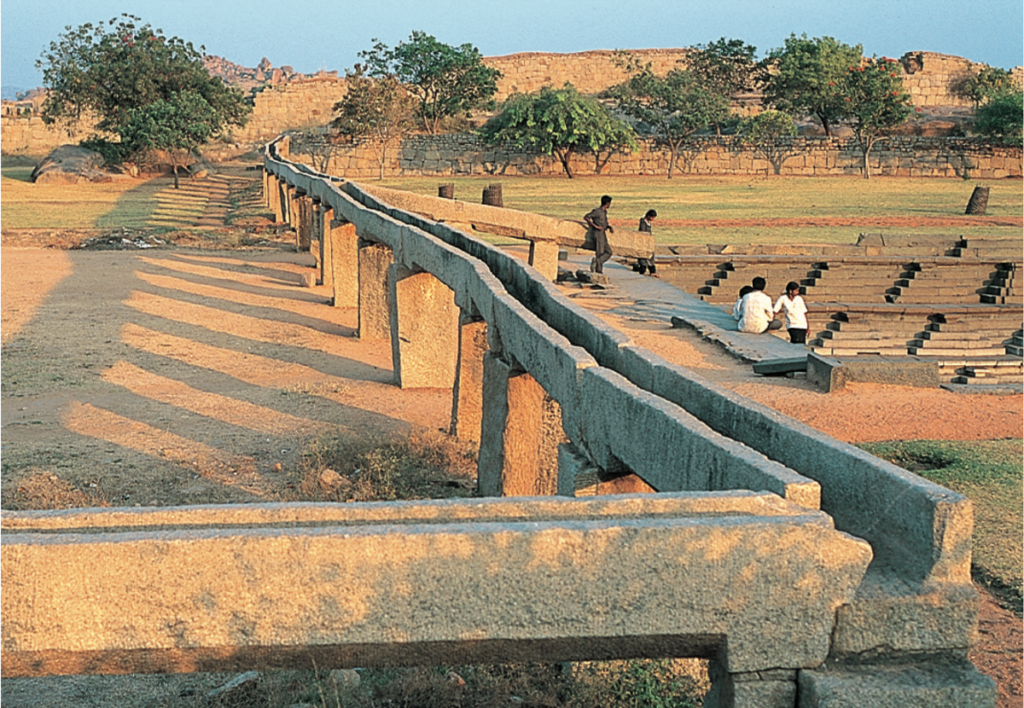Ancient water systems across the Deccan
 Stone aqueduct conducting water through the royal centre, Hampi Vijayanagara. Photograph by John Gollings.
Stone aqueduct conducting water through the royal centre, Hampi Vijayanagara. Photograph by John Gollings.
As we transition through the summer rainy season, we just launched a new series on the DHF Instagram page exploring ancient water systems and age-old conservation practices. With acute water shortages in many Deccan communities, preserving these structures is crucial.
These ancient water structures were functional marvels with deep cultural and religious significance, often integrated into temples and palaces, supporting agriculture, urban settlements and trade. Beyond practical use, these systems highlight a community-centric approach to resource management, emphasising collective responsibility and environmental stewardship—principles still relevant today.
A stepped tank in Hampi Vijayanagara

This stepped tank in Hampi was discovered by the Archaeological Survey of India in the mid-1980s. It is made from chloritic schist blocks and the basements of several residential structures, labelled as palaces by the excavators. The blocks are inscribed with numbers and letters indicating directions, suggesting the possibility that the tank was dismantled at some far-off site and transported piece by piece to the capital, where it was reassembled.
Read more about the history of the capital on the banks of the Tungabhadra River in our guidebook Hampi Vijayanagara.
Hyderabad's stepwells that are in need of restoration

Telangana has hundreds of historic stepwells, and many are in Hyderabad itself. The Bansilalpet Stepwell has been successfully restored and has become a venue for concerts and community events. Many other stepwells, like the three on the campus of Osmania University, await to be restored. The DHF is currently raising funds to help restore them and alleviate water scarcity. This project will rehabilitate an entire ecosystem within a watershed area.
Learn more about the Stepwells at Osmania University on the DHF website.
Rock-cut cisterns at a 2nd century monastery

The rock-cut caves at Kanheri are the most expansive monasteries in Maharashtra – just outside Mumbai – that date back to the middle of the 2nd century CE. Monastic life depended on the rock-cut water cisterns, usually cut out of the cliffs next to cave entrances.These cisterns filled with rainwater during the monsoon provided water for monks and nuns at the monastery throughout the dry seasons that followed.
Some of these rock-cut cisterns are filled with water all year long, and can be seen beside the paths leading to the caves at Kanheri, together with the channels that once conducted water to the monastery.
Explore more in our guidebook on the Buddhist Rock-Cut Monasteries of the Western Ghats
Reviving an ancient water system in Bidar, Karnataka
One of the DHF’s earliest restoration projects was the revival of the Qanat/ Karez system of Bidar. The oldest in the Deccan, it was introduced by immigrants from Iran in the 15th century, and then adapted by local experts to the particularities of the Deccan’s geological formations.
After developing a solid waste management system that currently filters the water, the DHF is now working on installing a liquid waste management system that will both protect the tunnel from contamination and support the landscape of the areas around the wells and the original water source.
Learn more about the Deccan in our comprehensive travel guidebooks, which are available in both paperback and digital format on the DHF Bookstore.
Get in touch with us about how to get involved and support our ongoing restoration projects. Visit our website for more information here.

